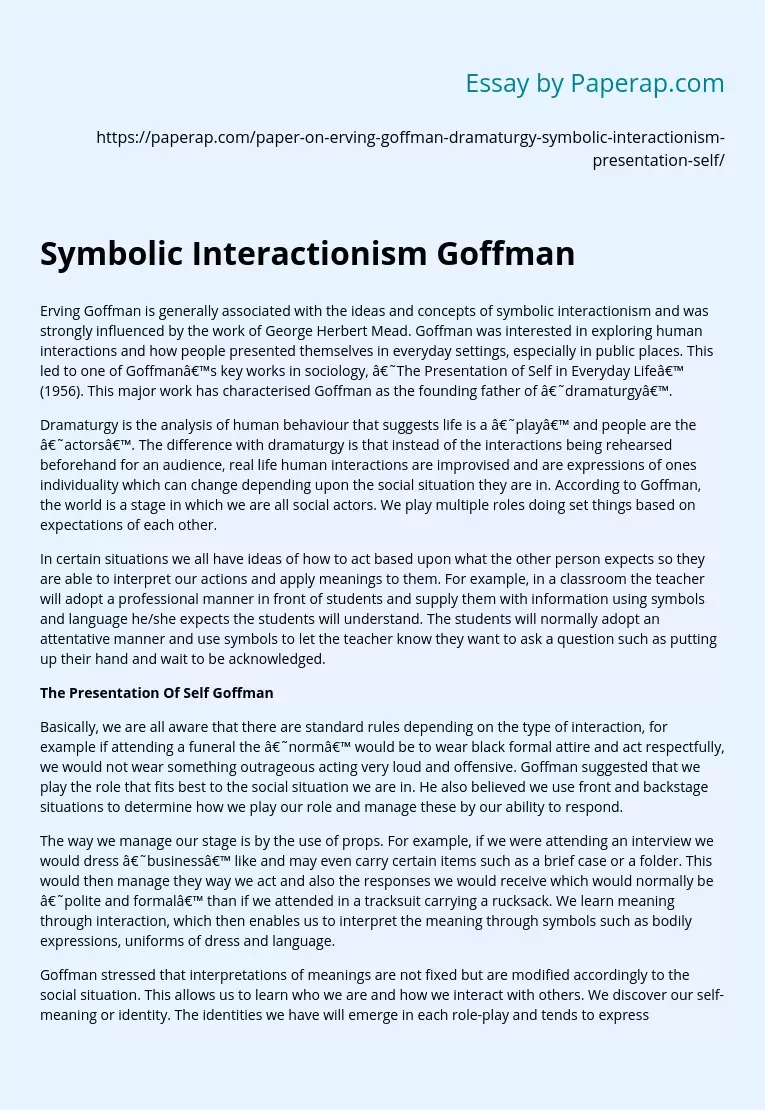Symbolic Interactionism Goffman
Erving Goffman is generally associated with the ideas and concepts of symbolic interactionism and was strongly influenced by the work of George Herbert Mead. Goffman was interested in exploring human interactions and how people presented themselves in everyday settings, especially in public places. This led to one of Goffman’s key works in sociology, ‘The Presentation of Self in Everyday Life’ (1956). This major work has characterised Goffman as the founding father of ‘dramaturgy’.
Dramaturgy is the analysis of human behaviour that suggests life is a ‘play’ and people are the ‘actors’.
The difference with dramaturgy is that instead of the interactions being rehearsed beforehand for an audience, real life human interactions are improvised and are expressions of ones individuality which can change depending upon the social situation they are in. According to Goffman, the world is a stage in which we are all social actors. We play multiple roles doing set things based on expectations of each other.
In certain situations we all have ideas of how to act based upon what the other person expects so they are able to interpret our actions and apply meanings to them.
For example, in a classroom the teacher will adopt a professional manner in front of students and supply them with information using symbols and language he/she expects the students will understand. The students will normally adopt an attentative manner and use symbols to let the teacher know they want to ask a question such as putting up their hand and wait to be acknowledged.
The Presentation Of Self Goffman
Basically, we are all aware that there are standard rules depending on the type of interaction, for example if attending a funeral the ‘norm’ would be to wear black formal attire and act respectfully, we would not wear something outrageous acting very loud and offensive. Goffman suggested that we play the role that fits best to the social situation we are in. He also believed we use front and backstage situations to determine how we play our role and manage these by our ability to respond.
The way we manage our stage is by the use of props. For example, if we were attending an interview we would dress ‘business’ like and may even carry certain items such as a brief case or a folder. This would then manage they way we act and also the responses we would receive which would normally be ‘polite and formal’ than if we attended in a tracksuit carrying a rucksack. We learn meaning through interaction, which then enables us to interpret the meaning through symbols such as bodily expressions, uniforms of dress and language.
Goffman stressed that interpretations of meanings are not fixed but are modified accordingly to the social situation. This allows us to learn who we are and how we interact with others. We discover our self-meaning or identity. The identities we have will emerge in each role-play and tends to express our beliefs in relation to social categories such as class, race, gender and age. Symbolic interactionism is a micro-theory that is explained by interpretivist sociologists who view society as being made up of social interactions so study social action.
In contrast, positivist sociologists believe that the social structure determines human behaviour and therefore study social facts. They examine the relationship or effect that social structures, or institutions have on members of society which are organised in terms of rules. Therefore, it could be argued they are studying social facts that which have already occurred created by the social interactions of the members of society and not by the social structure. However, the social structure, or institutions all have ‘rules’ which forms the ‘common ground’ for society.
By this I refer to as mentioned earlier, we all have ideas on how to act based on mutual expectation. Therefore, the common ground rules of tradition and institutions could be the starting point to which we base our interactions and apply meanings to. Structuralists have criticised Goffman on this point because he only studied interaction at a micro-level. However, this does not mean that the positivists are correct in their assumption that society is determined by the structure. Both theories are neither right nor wrong in their analysis.
It could be argued that both the micro-level and macro-level methods are closely connected in how society works. Society is too complex to be made up of just one thing. Humans are complex and need to adapt their actions and the way they present themselves accordingly. We are able to think, attach meanings to actions and interpret what is happening, and it is reasonable to suggest that it is the structure and the environment that we use in order for us to support and manage our actions.
Symbolic Interactionism Goffman. (2019, Dec 05). Retrieved from https://paperap.com/paper-on-erving-goffman-dramaturgy-symbolic-interactionism-presentation-self/

